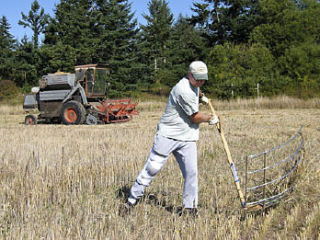Two ways to harvest grain: David Zapalac’s cradle scythe and Gary Buffum’s combine.
In fields that today are used only for hay, earlier generations of Lopez farmers raised wheat for their families and barley and oats for their farm animals. For the past several years, various Lopezians have imagined returning hay fields to grain production, and most recently Lopez Community Land Trust’s (LCLT) Sustainable Agriculture and Rural Development (SARD) program has asked, “What will it take to renew grain farming on Lopez?”
Their short answer is: soil, seed and equipment. For the longer answer, SARD committee members shared Grain Project Leader OJ Lougheed’s Grain Project Update and his Wheat on Lopez report with me.
Though technically an LCLT intern, OJ brings not only thirty-three years experience of research and seed growing in the Pacific Northwest and Siberia but also, and perhaps more importantly, a passion and vision for growing non-GMO, non-patented, organic, climate-appropriate grains to feed local communities.
In the Grain Project Update, OJ identifies soil fertility and soil improvement as priorities and proposes fall research plantings of “tillage radishes,” a type of Diakon radish.
“In addition to biologically—and physically—breaking up compacted soil, the radish also sequesters large amounts of nitrates which would otherwise be leached by the winter rains. This nitrogen is then released during the spring and early summer as the radishes decompose.”
Fertile, friable soil is a first step but the second, more challenging series of steps is determining grain varieties that do well here; locating seed that is certified organic; and, most important, seed that can be shared among farmers for future plantings. Though OJ reports that the project moved ahead in each of these seed areas, he also described some obstacles the project encountered this year.
The weather was one.
“During a late May 2009 workshop, WSU Extension distributed ten varieties of small grains: five wheats, three barleys, two oats. Several individuals planted small plots of two or more varieties in their gardens. Forty-nine days of no rain followed. Three people irrigated their plots; all others failed.”
The difficulty in finding non-patent protected seeds and certified organic seeds was another.
“All of the wheat varieties distributed by WSU are Plant Variety Protected (PVP) under Federal Law. This means that farmers may grow and save seed for their own use, but may NOT sell, share, trade or give away seed for planting by others.”
In addition, none of the WSU seed was certified organic.
Undaunted, OJ looked ahead to fall and winter, sourcing “seven varieties of non-PVP winter wheat and the first winter malting barley (also non-PVP).” To utilize winter rains, “11 growers, representing the three big islands, ranging from ten acres down to small garden plots, have agreed to plant this seed this fall.”
By late next summer, it should be ready to harvest.
But harvest time brings equipment needs. Anticipating them, SARD distributed a questionnaire to Lopez Island farmers to find out who owned harvest equipment and was willing to share it. They discovered that “there are four combines—two operational.” While these combines are suitable for the largest island fields, they aren’t for mid-size and smaller plots. A couple of solutions are LCLT member David Zapalac’s prototype modern cradle scythe for harvesting mid-size plots and two Austrian sickles OJ purchased for small plots. Another is the purchase of a small Japanese or Chinese thresher. And after harvest, a critical need is for good seed-cleaning equipment.
Last month, OJ attended a WSU Fall Grain Harvest workshop and saw again the challenges of renewing grain production. Summarizing his experience and revealing once more his optimism, OJ wrote: “I trust that there will be further discussions based on these workshops and as fall planting proceeds. There is considerable need for further education, varietal trials, and just ordinary experience based on the real conditions of place. I am hopeful that the possibility of a small ‘industry’ of grain (and other) seed production on the islands, as well as growing increasing amounts of our own grain, can become a reality. The Islands are at the center of the Salish Sea region, and eventually, given a post-oil sail-driven distribution network, and with the dry(er) climate, the Islands can play an important role in the increasing self-reliance of this part of the world.”
To read more about the Grain Project, go to: http://www.lopezclt.org/ and click on the grain photo.



